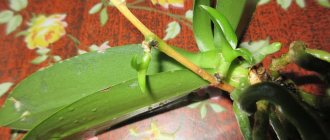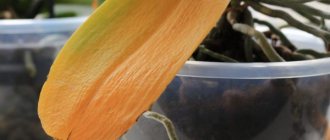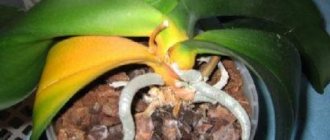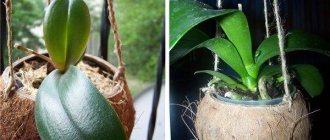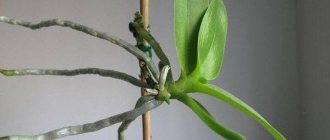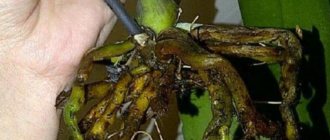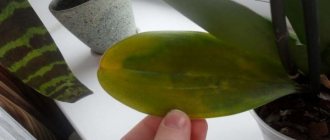The main reasons for broken peduncles in orchids
Inexperienced orchidists sometimes ignore the fact that before flowering it is necessary to immediately tie the arrow with the buds and direct it in the right direction. In phalaenopsis, the arrow emerges from under the bottom leaf and can then grow parallel to the floor. If it is not tied to a support in time, it will soon break from the weight of buds and flowers. The support is inserted into the pot as soon as the peduncle appears, and it is attached to the support using hooks that do not interfere with the further blooming of the flowers. Such fastening allows not only to reduce the breakdown of the peduncle to zero, but also to control the direction of the growing shoot.
But there are also a number of subjective reasons for damage to arrows with buds. This:
- Poorly chosen place, cramped space. To get to each plant you need to move the pots, and orchids don’t like to be disturbed. Moving pots from place to place increases the risk of harming the peduncle.
- Presence of pets in the house. Cats throw flower pots onto the floor, damaging leaves and shoots with buds and flowers. Pets should have limited access to the room with orchids.
Does it make sense to restore a broken peduncle?
A completely broken off flower shoot will never completely grow together with the surviving part . Some gardeners attach the broken arrow to its surviving part using a breathable adhesive plaster, but this is not always a good solution. It is better to cut it off with pruning shears and then the remaining area will be able to continue flowering.
You can try to connect the parts of the peduncle with adhesive tape.
The arrow is broken
If a broken peduncle or its tip is found on a plant, inspect the place of the break. There is no point in leaving the arrow hanging on one skin; it will dry out in any case. Wrapping the wound with tape or band-aid does not bring any results. The broken part is removed in any situation. But, there are pruning features depending on the location of the damage.
If an orchid has a broken peduncle, but there is a living bud below the damage, then most likely it will wake up and the plant will shoot a new arrow from this bud. After all, phalaenopsis is already ready to bloom. It will be more modest, but will still please the owner. It's a completely different matter when the peduncle breaks off at the very base. In this case, the arrow is cut off completely; it will still dry out, and the grower will have to wait until the orchid produces a new shoot.
Experts in growing orchids believe that damaging the arrow and removing it does not harm the plant and does not affect its further development. You can even see some benefit in this. By removing the broken arrow, the owner stimulates the flower to throw out a stronger peduncle.
Attention! If signs of any disease are detected in the orchid, flowering is stopped artificially so that the plant has the strength to recover.
Trimming
Pruning of the peduncle is done with a sharp sterilized instrument in the following cases:
- Its damage. When a peduncle is broken, it is cut off with a sharp, densified instrument just above the first living bud or at the base if the arrow is broken at the very bottom. The cut area is sprinkled with dry cinnamon, finely ground activated charcoal or charcoal.
- When the flower stalk has faded. In this situation, the cut is made above the first living bud, going up 1 cm.
- The arrow began to turn yellow and dry out at the top. In this way the plant shows that it does not need a peduncle. Pruning is carried out above the lowest living bud. After resting, the orchid will produce a new shoot from this bud for flowering.
Broken flowering branch
Beginners who are faced with the problem of a broken arrow for the first time do not know what to do. If an orchid has a broken peduncle with blooming flowers or swollen buds, it is cut off with a sharp stationery knife or a special device and placed in water. An arrow with blooming flowers can delight the owner for from 2 weeks to several months. And the best way to avoid breaking a flowering branch is to tie it to a support.
Orchid restoration
After damage and removal of the peduncle, the orchid needs a certain time to recover, which can last from 2 to 6 months. Most often, the recovery period is painless, and the orchid produces a new shoot with buds. But the owner needs to provide the green pet with:
- suitable temperature conditions;
- lighting;
- air humidity.
Bud fading and growth stimulator
Sometimes orchid growers stumble upon yet another problem and don’t know what to do. The orchid's peduncle is partially broken, 1 or 2 buds remain, but they do not dry out or develop. To awaken them, cytokinin paste is used. In order not to destroy the kidney, but to give an impetus to its development, do the following:
- A toothpick or needle is treated with alcohol.
- Carefully bend back the scales covering the bud.
- Apply a drop of paste to a toothpick and cover the surface of the kidney with it.
- Provide a difference between night and day temperatures of 2-3 degrees.
- When two shoots appear from a bud, one is removed and the cut is sprinkled with crushed activated carbon.
Attention!
Different amounts of paste used will give different results. An increase in the stimulant can give rise to shoots - babies or lead to drying out of the bud.
You may be interested in:
The orchid (Phalaenopsis) has faded - what to do next? Phalaenopsis is one of the most common and low-maintenance types of orchids. As a rule, in stores...Read more...
When the stem breaks at the base
If there is only one bud left on the broken peduncle, then the tip of the damaged stem is treated with crushed activated carbon or cinnamon. This will help disinfect the plant, and after a while it will begin to recover on its own. If this process goes without problems, then after some time the remaining bud will give a new arrow.
If the bud begins to freeze, you will have to use a growth stimulator. Cytokinin paste is most suitable for orchids. It should be used as follows:
- using a needle or toothpick disinfected with alcohol, carefully bend the upper scale of the bud;
- Coat the inside of the kidney evenly with a small amount of the drug. A small drop on the tip of a needle or toothpick is enough for this;
- To stimulate growth, place the plant in a place where the difference between day and night temperatures will not exceed 2 degrees.
If everything is done correctly, then after some time a new shoot will begin to appear from the bud. More than one shoot is not required, so if there are two, one must be removed. Don't forget to treat the cut area with a disinfectant.
Disease Prevention
When growing their plants, orchids are sometimes faced with the complete drying out of the stem left from a broken branch. To prevent drying out of the entire above-ground part of the plant, the shoot is cut with a sharp stationery knife treated with alcohol or chlorhexidine. If part of the base is affected, it is cut off to healthy tissue. After the surgical procedure, the cut is allowed to dry and sprinkled with crushed activated charcoal or charcoal to eliminate microbes through open wounds.
The second preventive measure to save the plant is the treatment of the above-ground part of the flower with biological preparations. Their use will not harm the flower, the owner, or pets. Used for processing:
- phytosporin (alirin, gamair);
- mikosan;
- Glycladin.
The preparations are diluted according to the instructions and treated not only the green parts of the plant, but also the substrate in which the orchid is grown, since the main part of the fungal pathogens live there; when they evaporate, they rise into the air and end up in open wounds. In this case, we are talking about saving the flower, and not about the formation of a new flower shoot.
Trimming
If the broken peduncle has broken completely or there is no waiting bud below, you need to cut it out completely . Since it will take a long time to dry out and then a new shoot will have to wait longer. If there is still a bud on the remaining shoot stump, it will continue to grow and form a flower.
Basic rules and nuances
There are certain rules by which you can trim:
- determine the top cut point;
- we find a waiting bud and step back 3 cm above it and make an even cut with pruning shears;
- The cut area must be treated with wood ash or brilliant green.
The instrument used for cutting must be sterile. That is, it must be wiped with a cotton swab dipped in alcohol.
If after pruning the peduncle does not turn yellow or dry out, then you can hope for it to bloom again . If it dries out, then it must be cut out before the next waiting bud.
Peduncles are cut off above the waiting bud.
If this does not stop the shoot from drying out, then it is cut out as close to the trunk as possible, not forgetting about processing. The only difference will be that the cut itself will need to be covered with garden varnish, because often the shoot is hollow and so that moisture does not get inside the plant during watering, causing rotting, it is sealed.
Resuscitation of the root system
If, as a result of the actions taken, there is no improvement in the condition of the flower, but rotting of the roots has begun, then:
- leaves lose their elasticity, wrinkle, dry out;
- the plant does not hold well in the substrate and sways;
- the roots lose their green color and become slimy and black.
The main cause of rot is improper watering. Proper care involves alternating moisture with periods of dryness. The reason is the special structure of the orchid roots, covered on top with a special layer called velamen. Its main function is the ability, like a sponge, to absorb moisture from the air and substrate, and if there is an excess of it, and aeration is poor, and there is no drain to remove excess water, then velamen begins to sour and decompose.
If the orchid is suspected of rotting of the root system, immediately remove it from the container and inspect the roots. Resuscitation procedures are carried out in several stages:
- All slimy and blackened parts are removed down to healthy tissue. This can be seen in the light cut. If there are flower shoots, they are removed.
- The sections are disinfected and dried. Several crystals of potassium permanganate are dissolved in clean water to obtain a pink solution.
- The root system is immersed in the solution for 3 minutes.
- Then the plant is laid out on a towel to dry.
- The sections are treated with cinnamon, crushed activated charcoal or charcoal, and brilliant green.
- Leave for several hours for the wounds to dry completely.
You may be interested in:
How to save an orchid if its roots have rotted: tips, instructions An orchid can get sick and die as a result. Timely resuscitation measures will help return the plant to...Read more...
What types of damage occur and how to revive a flower?
A broken shoot is not a reason for frustration. Phalaenopsis can be saved. First you need to assess the current situation. What to do if the peduncle of an orchid breaks off:
- Partial stem break. If this happens and some of the buds remain, then the remaining buds will be able to open.
- The peduncle has completely come off, but there is 1 bud at the base. Often a stem grows from it. It will be thinner than usual and with few colors.
- The flower shoot withered after being damaged. The plant needs to be resuscitated. The normal temperature, light level and standard watering should be maintained.
If the orchid still has several small roots, you can try to save them. This can be done using a greenhouse. You will need an aquarium and a 10 liter plastic bottle. The greenhouse should be located in a warm place without direct sunlight. You need to pour expanded clay into the container, add sphagnum moss and plant the roots.
Growing new roots
The next step in saving the orchid is choosing the conditions for growing a new root system. And the main task is to stimulate the orchid to form roots. There are 2 fundamentally different methods:
- Conditionally wet. It is used in cases where the plant has lost all its roots.
- Conditionally dry. Used when part of the roots is preserved.
Conditionally wet method
Sphagnum moss spilled with water is placed in a container or glass jar. The plant is placed above it so that the base of the root collar does not reach the level of the moss by a few millimeters. The top of the greenhouse is covered with a plastic bag.
Attention!
Using this method, you can do without a substrate. Orchids are hung in closed containers with high humidity. New roots grow in the air, and do not go into the substrate, build up good velamen and have a healthy green color. Sometimes plant roots are grown in water, but this method is one of the most rarely used.
Conditionally dry method
In this method of growing the root system, a vessel (container, glass jar) is used, at the bottom of which clean, dry bark is poured. An orchid is planted in it and covered with a lid with ventilation holes. Leave unchanged for 3-5 days. Next, begin careful and careful watering along the edge of the container. After about a month, young roots appear.
Growing containers
A variety of containers are suitable for creating a greenhouse. The main thing that is necessary for the resuscitation of orchids is light, the presence of ventilation holes, and the same ambient temperature. The following are used as such greenhouses:
- glass jars;
- 5-liter bottles cut into 2 parts;
- old aquariums;
- food plastic containers.
You may be interested in:
How to properly prune an orchid after flowering: basic pruning rules Orchids such as phalaenopsis bloom twice a year. The period lasts about two weeks, and another type of it...Read more...
The orchid is one of the most capricious and mysterious flowers, but with skillful care it thanks to flowering that lasts up to 6 months. Therefore, gardeners who have achieved orchid flowering at home are considered professionals in their field. They are able to provide the plant with such care that the phalaenopsis produces and is able to provide food for more than 3 arrows at the same time.
Purpose of the flower shoot
When the dormant period of the orchid is over, the rested and gained strength plant releases a temporary shoot - a peduncle, with the appearance of which the flowering period begins. On the peduncle, buds form and grow , which bloom over time. The end of flowering means that the peduncle has fulfilled its primary task.
Read about what a peduncle looks like and how to distinguish it from a baby or root here.
Caring for a plant with a faded flower shoot
In order to avoid negative consequences, the orchid needs to be left alone for a while, but certain conditions must be met:
- despite the fact that a comfortable air temperature for an orchid in summer should be +22-25 degrees, and in winter – +16-18, in the first few weeks after trimming a dried peduncle, the temperature should be lowered to +20-22 degrees;
- reduce watering to a minimum, but do not allow the soil to dry out;
- limit the time the plant stays in the light and exclude too bright lighting;
- maintain air humidity at 50-60%;
- regularly ventilate the room, avoiding air stagnation;
- exclude fertilizers in the first month after the procedure, then feed no more than once a month;
- spray regularly with soft water, the temperature of which should be 35-40 degrees.
For some types of orchids, growing babies on a peduncle is the only way to reproduce in apartment conditions. Read about how to get orchid offspring and what to do if the plant does not shoot.
A dried orchid peduncle is not as terrible a phenomenon as it might seem and cutting it off if necessary is not at all difficult. The main thing is not to panic, but to sensibly assess the condition of the plant and, if necessary, take active action. Treat your orchid with attention and care, and it will thank you with its beautiful flowers.
